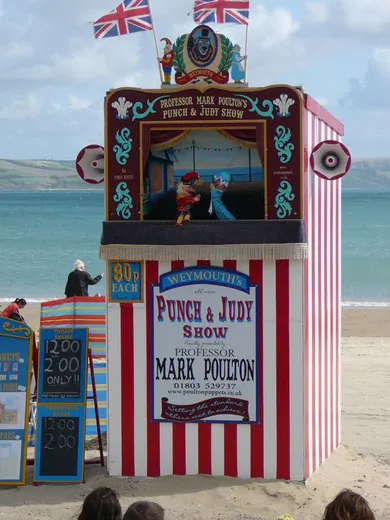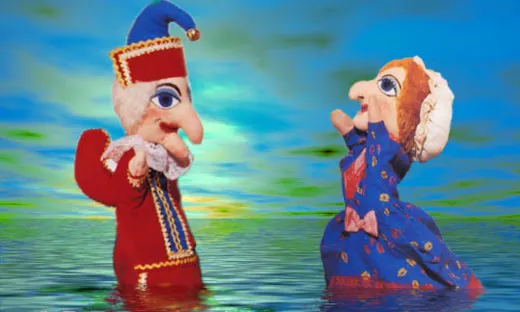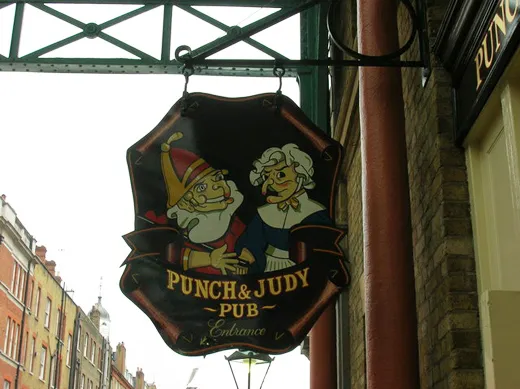Are Punch and Judy Shows Finally Outdated?
For a wife-beating, baby-squashing scofflaw, Mr. Punch has done pretty well for himself
/https://tf-cmsv2-smithsonianmag-media.s3.amazonaws.com/filer/Punch-Judy-Puppet-631.jpg)
A puppet show about wife-beating and sausage-eating sounds like something that would have gone the way of Shakespearean English or minstrel shows. For many confounding reasons, however, the Punch and Judy show remains, continuing to inspire laughs all over the world for more than three and a half centuries.
The show centers on Mr. Punch, a rascally hand puppet whose primary vocation is whacking his saucy, nagging wife, Judy, and various members of the constabulary with a stick. Mr. Punch has performed for English kings and American presidents, been chased by crocodiles at the British seaside and anacondas in Brazil, and even appeared in some of the first movies ever made. Not bad for a squawking, red-nosed puppet who hasn’t had a job in 350 years.
Mr. Punch’s influence on British culture is unparalleled. In 2006, the Punch and Judy show was named one of 12 icons of Englishness by the British government’s Department for Culture, Media and Sport—right up there with a cup of tea and the double-decker bus. To celebrate his 350th birthday in 2012, Mr. Punch was treated to an entire year of parties and was the focus of a six-month-long exhibition about him at the venerable Victoria & Albert Museum of Childhood.
But this most English of entertainers isn’t actually English in origin—he’s Italian.
Punch historians take the puppet’s first appearance in England as May 9, 1662, the day that compulsive diarist Samuel Pepys caught an “Italian puppet play” in Covent Garden. (In honor of that connection, Covent Garden has remained the spiritual home of Punch and Judy ever since; it’s still home to the Punch and Judy Pub, the kind of place that tourists love and locals avoid.)
Punch came to England at a moment of social upheaval. The country’s recent brush with republicanism had gone spectacularly off the rails after its leader, the deeply puritanical Oliver Cromwell, turned England into a dead zone of no theater, no dancing, no sports—no fun. Cromwell died of natural causes in 1658, and his faction soon collapsed with his son at its head. King Charles II was reinstated on the throne and Cromwell was posthumously tried, found guilty of, and executed for high treason in 1661. With Puritanism abating, artists and performing troupes from the European continent began to flood into England to fill the fun vacuum. Pulcinella rode that wave over as a marionette puppet.
“Pulcinella” was an Italian clown character of the commedia dell’ arte tradition. Pepys called the Covent Garden show “very pretty, the best that ever I saw,” and he wasn’t the only one who loved it. English showmen knew a good thing when they saw one, so they adopted Pulcinella or, after the name was mangled by English pronunciation, “Punchinello”; this was soon shortened and Anglicized to just “Punch.” Within a few years, he started to look like the Mr. Punch of today, with the protruding red nose and chin, the garish cap and clothing, and the humped back. He also sounded like him—since the beginning, performers voiced Punch using what’s called a “swizzle,” a reeded mouth instrument that produces a squawking, kazoo-y sound when spoken through.
But he didn’t yet have his own stories. In the late 1600s through the mid-1700s, Mr. Punch would be inserted into familiar, existing tales, such as Noah’s Ark, and given free rein to turn it into his own comedy. With him came “Joan,” his shrewish wife. Says Punch in Henry Fielding’s The Author’s Farce of 1729, “Joan, you are the plague of my life,/ A rope wou’d be welcomer than such a wife.”
“That kind of comic squabbling between male and female has a long pedigree in English drama,” said Glyn Edwards, a Punch performer for more than 50 years. Edwards, a self-professed “Punch activist,” calls Mr. Punch the “Lord of Misrule” and says that part of his enduring appeal is that he gets to do what everyone secretly wants to—thumb his nose at authority.
Punch and Judy soon became a staple of country fair entertainment, where they would have made both adults and children laugh. As England moved to a more industrial economy, the Punch and Judy show became street fare, losing the marionette strings and picking up the recognizable red-and-white-striped booths set up in market squares, or later, on boardwalks and beaches at the seaside. The show could now be performed by one person using two hand puppets: Mr. Punch and whomever he was punching at the time.
By the Victorian era, Joan had inexplicably become Judy and the show had more or less coalesced into what you see today—very broad, visual, whacks-to-the-groin comedy, with a dark underbelly.
A typical Punch and Judy show plays out as follows:
Mr. Punch is a “jolly good fellow” who likes to drink and chase girls; soon, however, he gives in to his comically gruesome homicidal tendencies. For example, in the 1827 Tragical Comedy or Comical Tragedy of Punch and Judy, the first published Punch and Judy script, he has a run-in with a dog, who bites his nose. When the dog’s owner comes along, Punch knocks his head clean off his shoulders with his “slapstick.” (The etymology of the word slapstick revealed!)
When Judy arrives, she goes to fetch their baby and leaves it alone with her husband. Mr. Punch proceeds to (your pick) knock the baby against the stage, throw it into the audience, toss it out the window, put it through his sausage-making machine(!), or even sit on it. Judy retruns and is outraged, so Mr. Punch beats her to death with the stick (!!).
When the Policeman, Doctor or some other authority figure comes to investigate, Mr. Punch whacks him with his stick. Should Joey the Clown show up, he too will be chased off or murdered by the stick-wielding Punch.
In some of the earlier versions, Mr. Punch was ultimately arrested and brought to the Hangman’s noose—but he manages to trick the Hangman into putting his own head in the noose, resulting in the end of the Hangman. Ultimately, Punch faces the Devil himself—and it’s usually Punch who wins, capping his murderous streak with the words, “That’s the way to do it!”
The violence, of course, has remained—and for that reason, Mr. Punch’s influence on children has understandably long been a source of worry. A New York Times article from February 11, 1896, describes children enjoying a Punch show on West 135th Street in Manhattan—and one “grave gentleman,” who resembled Punch “as if they were brothers,” grumbling at the policeman-beating scene and declaring, “It is a shame to show such things to children! How can you expect them to have any respect for the law?”
In 1947, the Middlesex County Council in England banned Punch and Judy from schools, prompting wide outcry from Punch fans and his eventual reinstatement. More than 50 years later, in 1999 and 2000, other councils in Britain considered banning Punch and Judy shows on the claim that they were too violent for children; they didn’t, but it was close.
This summer, Gold TV, a television station devoted to the old classics of British comedy, “rebooted” Punch and Judy. Punch was cast as a tracksuit-wearing benefits scrounger (welfare abuser) and Judy as a wannabe WAG (Oompa-Loompah-hued wife of a soccer player). Nick Clegg, Britain’s deputy prime minister, makes an appearance as “Cleggy the Clown”; Boris Johnson, London’s tow-headed mayor, is The Policeman; and Simon Cowell is, of course, the Judge. And, rather than sitting on the baby, Punch is caught trying to sell the child to an unnamed female pop star.
John Phelps and Gary Lawson were the writers behind the new script; Phelps defended his update as precisely what Punch needs to stay alive: “If they were first performing the same act from 350 years ago that they performed in Covent Garden, no one would be interested.”
One of the main reasons they were asked to update the show had to do with Punch’s homicidal habits. Gold TV surveyed 2,000 British parents of children between the ages of 5 and 12 and found that 40 percent of them thought the traditional Punch and Judy was too violent. “I think the violence, wife-beating and throwing the baby down the stairs isn’t really acceptable these days. And it shouldn’t be,” said Phelps.
Punch defenders claim that’s just modern oversensitivity. “Although adults get very upset about the violence, the bashing the baby, it’s no more real to a child than watching a cartoon, like ‘Tom and Jerry,’” says Cathy Haill, curator of popular entertainment for the Victoria & Albert Museum in London. “Ninety-nine percent of children will roar with laughter [at ‘Tom and Jerry’] and not think ‘Oh, I’ve got to write to the society for prevention of cruelty to cats’…Nowadays, people are far more— and I hate this term—politically correct and get ridiculously worried about things like this, in my view.”
“He’s one of those tricksters, imp of mischief figures,” explains Edwards, who was one of many professors (as the Punch and Judy performers are called) angered by the Gold TV reboot. There’s only so much updating you can do before it’s no longer Punch and Judy, claim the traditionalists.
“The tradition lifts him above being just a weird little man,” says Edwards; part of the point of the show is that this clown “kind of wreaks havoc” and is “flouting society’s conventions so that society can laugh at the absurdities that are revealed.”
One of the reasons the show is still around at all—showing remarkable resiliency through the advent of movies (some of the very first films depicted the puppets), video games and personal technology—comes down to nostalgia, Edwards says. “It’s been always a kind of retro entertainment, it’s always been reminding its audience of a slightly mythical golden era.”
It’s also an incredibly malleable show; over the years, Mr. Punch has beaten up everyone from Hitler to Margaret Thatcher to Tony Blair.
Britain may be where Mr. Punch found fame, but he’s beaten his wife in every country the British ever colonized. There’s a grand American tradition of Punch and Judy: One of the first puppet shows performed in America was A merry dialogue between Punch and Joan, his wife, in Philadelphia in 1742; George Washington, according to his accounting books, purchased tickets to see a Punch show; and Harry Houdini even did a Punch show during his early years as a magician with a traveling circus.
The show was adapted to suit American humor, says Ryan Howard, professor emeritus of art history at Morehead State University and author of Punch and Judy in 19th Century America. “In the American [versions], there were a lot of Germans and Jews and black people, I think reflecting the racial and ethnic diversity of our country,” says Howard, acknowledging that the laughs were often at the expense of the minority characters.
Mr. Punch has managed to survive several moral panics so far and his fans seem to think he can go on doing so. “As long as there are people who can make a living out of doing it, I think Punch will survive,” says Haill. “He’s got to 350 already and I see him making at least another 100 years.”
/https://tf-cmsv2-smithsonianmag-media.s3.amazonaws.com/accounts/headshot/LindaRodriguezMcRobbieLandscape.jpg.jpeg)




/https://tf-cmsv2-smithsonianmag-media.s3.amazonaws.com/accounts/headshot/LindaRodriguezMcRobbieLandscape.jpg.jpeg)